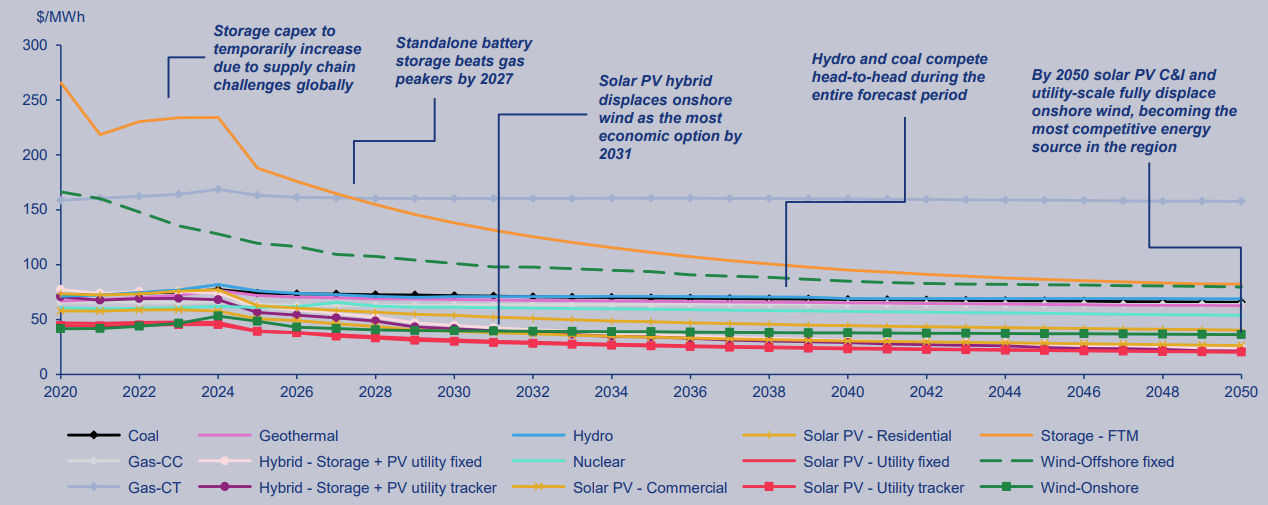Get in touch
-
Mark Thomtonmark.thomton@woodmac.com
+1 630 881 6885 -
Hla Myat Monhla.myatmon@woodmac.com
+65 8533 8860 -
Chris Bobachris.boba@woodmac.com
+44 7408 841129 -
Angélica Juárezangelica.juarez@woodmac.com
+5256 4171 1980 -
BIG PartnershipWoodMac@BigPartnership.co.uk
UK-based PR agency
Solar PV to overtake onshore wind in Latin America from 2023
Solar leads as lowest cost technology to 2050, superseding all other power generation technologies in region
3 minute read
Solar PV will become the most cost-competitive technology in Latin America from 2023, according to Wood Mackenzie’s latest research report, ‘Latin America levelized cost of electricity (LCOE)’ which examines the power technology and generation landscape across the region to 2050. Solar will also displace onshore wind, currently the most attractive renewable energy source in Brazil, by 2025.
Wood Mackenzie, a Verisk business (Nasdaq: VRSK), forecasts that solar will remain the lowest cost of energy of all technologies in Latin America until 2050, with US$14 per megawatt hour (MWh).
Leila Garcia da Fonseca, Research Manager – Latin America Power & Renewables at Wood Mackenzie, said: “Power demand in Latin America is set to almost double by 2040 compared to 2021 levels – a higher growth rate than North America. Yet, despite the region already being a frontrunner for renewable power generation, questions remain about how Latin America will contribute to the global energy transition effort.”
“Our LOCE analysis reveals which technologies will be competitive up to 2050 in Latin America, helping clients get an understanding of how countries in the region are supporting global decarbonisation,” Garcia da Fonseca continued.
Average LCOE in Latin America, 2020-2050 (US$/MWh)

(Source: Wood Mackenzie: GAPS Southern Cone and Mexico)
Wood Mackenzie’s latest report shows that exceptionally high capacity factors in Mexico will allow its solar market to achieve the lowest LCOE among all countries in the outlook, followed by Chile.
Garcia da Fonseca added: “Expected solar cost reductions are significant, with average capital investment falling by 55% from 2022 to 2050. This is mainly led by technology improvements, such as bifacial modules becoming the norm across the region in the mid-term.”
Offshore wind will be the most competitive in Brazil and Colombia, offering the two lowest LCOEs in the region, with US$ 79.7/MWh and US$ 57.3/MWh respectively by 2035. On-site electrolyzers preclude the need for transmission investment, which translates to an additional 13% in offshore wind LCOE reduction. However, offshore wind costs will drop 46% in the region and will not reach grid parity with other renewable technologies.
“For onshore wind, current supply chain challenges and high inflation will cause a sharp increase in costs by 2024, followed by a slow recovery. Onshore wind LOCE in Latin America already falls below Combined Cycle Gas Turbines (CCGT), except for Argentina,” Garcia da Fonseca said.
After 2033, onshore wind remains cheaper than gas in all countries across the region until 2050.
Off-grid applications for green hydrogen production is currently the main driver for offshore projects in Latin America, with the first projects expected to be online as early as 2032.
Standalone storage has the highest cost reduction rate among all technologies, averaging 64% across countries in the region. The rapid cost reduction of solar and standalone energy storage will result in extremely attractive LCOE levels for hybrid projects in the region, with US$ 21.4/MWh anticipated by 2050.
“We expect the attractiveness of conventional sources to lessen over time as ESG mandates grow. With limited opportunity for innovation, prospects for significant cost reductions for hydro and thermal plants are null. Increasing regulatory and environmental barriers will also make such projects less financeable and therefore more expensive,” Garcia da Fonseca concluded.
ENDS
About the report
Wood Mackenzie’s latest report ‘Latin America levelized cost of electricity (LCOE)’ provides an analysis of power technology and generation cost trends and competitiveness from 2020-2050. This is the first time Wood Mackenzie has released this kind of analysis. The detailed data and assumptions used in this report are available in its accompanying data file with an embedded interactive tool.
LCOE definition
LCOE is equal to the power price required to reach a target rate of return (IRR), generally after-tax equity IRR. Alternatively, LCOE is equal the ‘break-even’ price when levelised lifecycle costs equal levelised revenue.
A summary of LCOE methodology
LCOE is a standard power industry metric used to measure the total cost of power generation averaged per megawatt-hour over a project’s lifetime.
Energy storage
Energy storage applications will be mainly represented by hybrid generation solutions as most countries in the region lack stronger remuneration mechanisms for standalone battery projects.
Capacity factors
A capacity factor is the ratio of actual electrical energy output over a given period of time to the theoretical maximum electrical energy output over that period.





